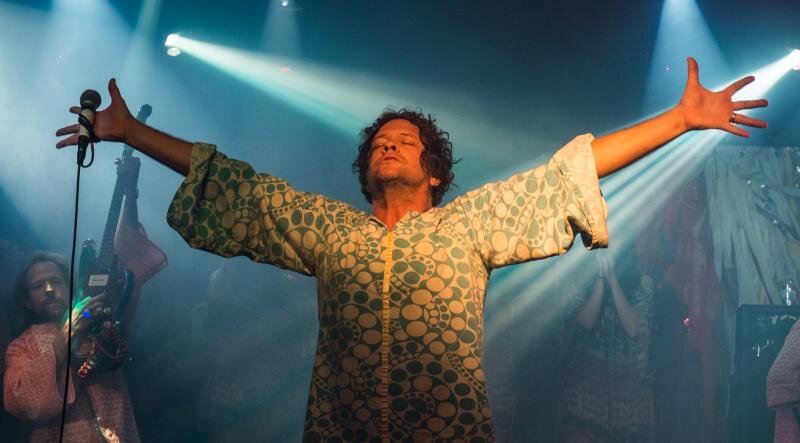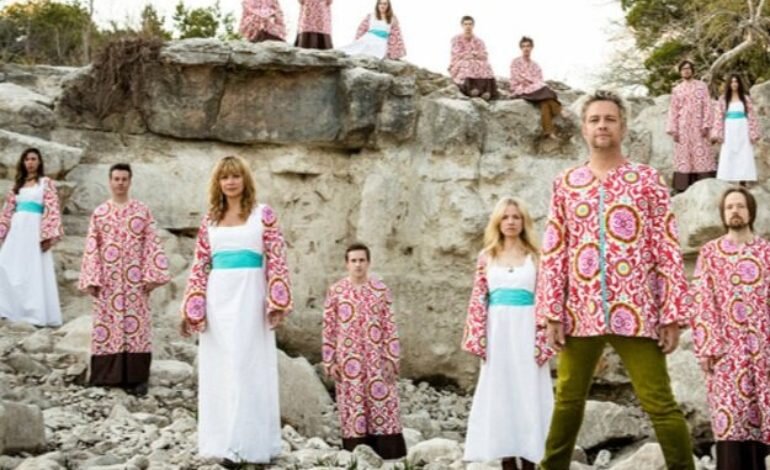Last Night: A Smaller Spree?
The Polyphonic Spree still fill a stage, but not with as many people as they have in the past when they played New Orleans last weekend. Not that it mattered.
At this point, The Polyphonic Spree’s career has followed a familiar modern arc. They made the album that got the Dallas-based psychedelic band its initial buzz, then the album that delivered more of the same but the buzz chasers moved on. They made the album that was definitely not the previous thing—The Fragile Army, with the group trading in its white, flowing choir robes for black, tailored, military uniforms—but after the press noticed the new wardrobe, the band’s fortunes remained largely static. From there, they go on to make their music to the audience has stayed with them, changing a little with the times but staying fundamentally themselves.
The details of that story might not be exactly right, but that’s what it looks like from the cheap seats, and it's roughly the story of indie rock bands today. That narrative has to be maddening because it’s more about audiences and tastemakers and their hunt for the newest thing than it is about the band and it's music, but it mattered for The Polyphonic Spree when it played New Orleans Sunday night because they’re not sufficiently buzzy nor so big that they can get an audience to go anywhere to see them. On the final night of their tour, the band got the ego whip that comes with being big enough to motivate fans from Scotland to fly in to see it, but not big enough to get New Orleanians to cross the parish line on River Road in meaningful numbers to see it at Southport Hall. The Labor Day weekend made the challenge tougher, as did Southport’s almost non-existent promotion for the show. As a result, the Spree played a joyous show that would have been more celebratory had there been more people to be a part of it.
The Spree was down to a svelte 15 members with a mere four women in the choir, but the extra voices weren’t missed. Band members were dressed for a more psychedelic presentation that included streamers hanging behind the band and six disco light balls onstage that illuminated some songs with rotating poles of light. It was as low tech but effective, much like the strip of cloth hung between poles on the opposite ends of the stage to obscure the band as it set up. Backlit as the band began, singer Tim DeLaughter wrote on it with Sharpie “NOLA Lives & Wins!” starting with the final exclamation point and writing backwards to build some drama. Then he cut the sheet with shears so that it fell away to start the show.
Not surprisingly, the set relied heavily on last year’s Yes, It’s True, which is slightly more dance-oriented than the band’s signature, sweeping, uplifting, melodic pop. In that mode, Polyphonic Spree can recall Bowie and The Beatles, but not so much as to sound derivative, and it didn’t matter. The solidity of the songs’ pop pleasures and the energy that many people can create made the songs about the moment, not their provenance. And the band also seemed comfortable in itself, not dancing coyly around the cult/not-cult questions that followed the robed incarnation and the reaction/not-reaction of the Fragile Army phase. They showed more of a sense of humor than I remember, dedicating a song to Cher and telling the story of a musician hearing and stealing the first song the 12-year-old DeLaughter wrote and then playing it: McCartney’s “Live and Let Die.” His lyrics are still full of positivity, and he’s still trying to coax the band and audience into greater swells and surges, but the whole enterprise seems conceptually simpler and more direct because of it.
As enjoyable as the hits are, the moments that stayed with me afterwards were the droning, very trippy cover of “The Porpoise Song” from The Monkees’ Head and DeLaughter going into the audience where he coaxed the audience to sit on the floor then joined them to sing “Battlefield” from Yes, It’s True with the horn players behind us gently blowing their parts. The former was simply the Spree making the weird into pop—or was it making pop weird?—and the latter made a great moment out of the situation. If you have a crowd that allows for intimacy, why not have it?
As a fan, you feel for the band knowing that—barring something amazing—it’s story is going to remain something like this. There will be cities and situations where The Polyphonic Spree will do well and others where the choice of venue could help, but it’s never going to become a mass thing. You also wonder where everybody is, and why they don’t get this, particularly after seeing a show as generous and fun as Sunday night’s.











